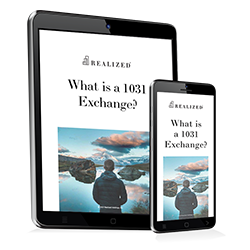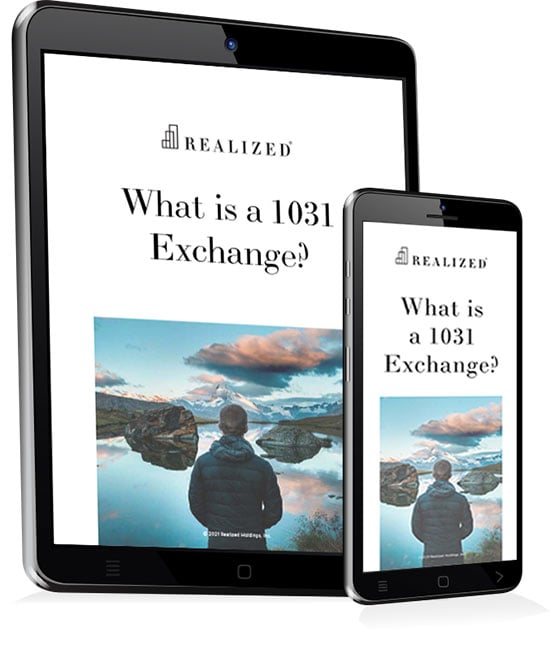
The IRS has relatively flexible rules on what types of property qualify for a 1031 exchange or like-kind swap. However, there are a few types of real estate that toe the line between investment or personal use property, leading to confusion among new and seasoned investors alike. These assets include vacation homes and second homes.
These two properties do qualify for 1031 exchanges under certain circumstances. In this blog post, Realized 1031 lays out these scenarios so that investors can gain a better understanding of the 1031 exchange second home or vacation home qualification process. Keep reading to learn more.
Traditional 1031 Exchange Process: What Is Accepted?
According to Section 1031 of the Internal Revenue Code, investors must adhere to the like-kind requirement to ensure the tax-deferred status of their exchange. This concept is also called “1031 qualified use.” For example, if your current (relinquished) property is an apartment building, then you can swap it for properties used in a similar manner, such as a commercial center or a multi-family home.
Primary residences, which aren’t held for business or investment use, are one of the few restricted types of real estate properties. You cannot exchange this asset for another primary residence.
Vacation homes and secondary homes are in between personal use and investment use, leading to confusion regarding their eligibility to fall under qualified use. In the past, investors and experts alike were unsure whether these properties were allowed in a 1031 exchange.
A Brief History of Various Rulings and Regulations on Vacation Homes
Given the nebulous categorization of vacation and second homes, the IRS and Department of Treasury have issued several rulings over the years. However, these stipulations led to contradictions and even more confusion.
Private Letter Ruling 1981-03117
The first attempt to address the 1031 exchange vacation home qualification issue is the Private Letter Ruling (PLR) 1981-03117. A private ruling is a type of written expression by the Commissioner of Taxation, stating their opinion on the administration of certain schemes. In this case, PLR 1981-03117 allowed investors to exchange vacation property for investment property if the relinquished property was held for both investment and personal enjoyment. Eventually, this 1981 private ruling would be challenged by the Deferred Exchange Regulations.
Deferred Exchange Regulations
In 1991, the Department of Treasury released the Deferred Exchange Regulations. This was a set of rules that mandated which types of assets were qualified for tax deferral or exchanges. To be more specific, the Deferred Exchange Regulations only allowed assets held for investment or business use for like-kind swaps. A notable absence is vacation homes, particularly ones that aren’t used for rentals or investment.
Thanks to the Deferred Exchange Regulations, many experts believed that investors must demonstrate their intent to hold the vacation home for investment or business purposes before they could exchange. This went into direct contradiction to PLR 1981-03117.
Tax Court Memorandum 2007-134
It wasn’t until 2007 that another ruling was made. This time, it was the United States Tax Court that issued Memorandum 2007-134. The focus was on the investor’s intent. If the investor’s real intent was to acquire, hold, and use a property for personal use and enjoyment rather than business or investment purposes, then they would not qualify for a 1031 exchange.
Given this stipulation, it becomes more important to determine the investor’s intent during the sale of the asset. Whether they have other plans before the sale or disposition is irrelevant. As such, clarity on the property’s use became important for investors who are considering it for a 1031 exchange.
Why Are Vacation Homes an Issue?
In the past, the lack of clear guidelines from the IRS regarding vacation and second homes was confusing for investors. The agency needed to clarify whether these assets could be exchanged if they were eventually converted for investment or business use. There was a question of whether these converted properties fall under the “qualified use” designation or not, putting their eligibility for a like-kind swap into scrutiny at the same time.
Treasury Inspector General’s Criticism Regarding 1031 Exchanges
This lack of clear oversight and guidelines prompted the Inspector General of the Department of the Treasury to issue a report in September 2007. The “Like-Kind Exchanges Require Oversight to Ensure Taxpayer Compliance” document addressed the lack of supervision for 1031 exchanges, particularly the vacation or second home 1031 exchange process.
Revenue Procedure 2008-16: Guidance on Vacation Properties and Second Homes
In their latest attempt to put an end to the criticism and make the guidelines clearer, the IRS released the Revenue Procedure 2008-16. The new stipulations provided safe harbor language that clarifies how and when a vacation or second home converted to an investment property can fall under qualified use property and become eligible for a like-kind swap as outlined in Section 1013 of the Revenue Code.
The term safe harbor, in the context of taxation, refers to the provisions that protect you from incurring penalties if you meet the conditions. Such stipulations are common in tax laws because of the ambiguity in verbiage, increasing the chances of non-compliance among taxpayers. With safe harbor laws such as Revenue Procedure 2008-16, you can potentially minimize disputes with the IRS.
Revenue Procedure 2008-16, which went into effect on March 10th, 2008, serves as the latest set of rules regarding the 1031 exchange vacation home qualification process. The procedure provides clear, safe harbor guidelines that help investors complete a like-kind exchange for their secondary or vacation properties. Do keep in mind that there are certain scenarios where safe harbor guidelines are unnecessary, and we’ll discuss those later.
For Second or Vacation Homes Held as Relinquished Properties
First, let’s discuss the requirements that make a vacation property you want to exchange or relinquish qualify for tax-deferred status.
- The investor must own the property in question for at least 24 months before the exchange.
- The property must have been rented to other people for at least 14 days in the preceding two years, and the rent rates must follow fair market rental rates.
- The investor must not have used the property for personal enjoyment for more than 14 days during the past two years before the exchange or for 10% of the total amount of days you rented the property. Letting friends or family stay at the property counts as personal use unless they paid fair market rental rates.
Defining “Personal Use”
Revenue Procedure 2008-16 also provided vacation or second home 1031 exchange rules for properties you’ve acquired.
- You must own or hold the property for at least 24 months after finishing the exchange. This timeframe is called the qualifying use period.
- You must rent the unit for more than 14 days during two twelve-month periods immediately after the exchange, charging the tenants based on the fair market rental rates and not lower.
- You must occupy the property for no more than 14 days or 10% of the days occupied by the tenant.
Defining “Personal Use”
What counts as personal use? To reduce ambiguity, the IRS has also outlined stipulations that define what counts as personal use. It goes without saying that staying and living in your vacation or second home is considered personal use. As we mentioned above, having relatives stay on the property also falls under this designation, especially if they use the property as their primary residence.
The only time a relative or friend staying won’t count as personal use is if they paid the fair market rental rates. Paying rent effectively turns these people into tenants, regardless of their personal relationship with you.
Fair market rental rates refer to the amount of rent a property would reasonably charge for tenants in an open market. The value is based on factors like the property’s size, location, and comparable rates within the area. By following the fair market rental rates, tenants have proof that the property is used for legitimate lease transactions and not as personal favors to their relatives or friends.
Like-Kind Exchanges Outside of the Safe Harbor Guidelines
Not all second or vacation homes are subject to the safe harbor guidelines or the restrictions in general. For example, vacation rental properties that are primarily used for rental use won’t have to follow safe harbor guidelines if an investor plans to exchange it for a like-kind property. Let’s say that a mountain cabin is listed on Airbnb or Vrbo for most of the year, and it has a clear income record from past tenants. If you try to exchange this property, you most likely won’t encounter issues. You rented out the cabin frequently enough to demonstrate your income-driven intent.
Best Practices When Exchanging Vacation Homes or Second Homes
The qualification process for vacation or second home 1031 qualification process can be daunting, especially if you’re unsure whether your property falls under the safe harbor guidelines. Thankfully, we’ve shared the best practices you can follow to increase your chances of a successful exchange.
Understand the Safe Harbor Guidelines
The best tip we can recommend is understanding and adhering to the Revenue Procedure 2008-16. Having a clear idea of what the guidelines entail serves as a foundation for what you’ll do next, such as limiting your personal use of the property or renting it at fair market rental values.
Keep Records of Rental Activity
The surest way to showcase your intent to invest in the property is by renting it. Maintaining detailed records of rental agreements, advertising efforts, and rental income helps establish your property as an investment asset.
Plan Conversion Ahead of Time
As the safe harbor rules mention, you should be using the house for rental purposes for more than 14 days within the past two years so it can be labeled as an investment asset rather than a personal-use property. As such, you must begin taking steps ahead of time to satisfy these requirements.
Consulting With 1031 Exchange Professionals
A traditional 1031 exchange is already complex enough as it is. Add the intricacies of the second home 1031 qualification process, and you have a higher chance of committing errors that remove your tax-deferred status. As such, it can be very helpful to work with 1031 exchange professionals such as our team at Realized 1031. We can provide guidance and solutions to help you navigate the safe harbor guidelines and 1031 exchange rules by and large.
We also recommend working with tax attorneys, financial advisors, and accountants to help with the process. With the guidance of experts, you’re less likely to make errors and can potentially maximize the benefits of a like-kind swap.
Wrapping Up: The 1031 Exchange Vacation Home or Second Home Qualification Process
Exchanging vacation properties or second homes comes with a few complications. In order for an asset to qualify, you must show clear intention for using the property as an investment rather than a personal residence. Following the safe harbor guidelines from the Revenue Procedure 2008-16 is one way to show this intent. The more investment or rental activity you can show, the less likely you’ll experience scrutiny, allowing you to finish the exchange without encountering any issues.
During planning, we encourage you to work with experts like us at Realized 1031. Our experienced team can provide the insight and solutions you need to increase your chances of a successful exchange. Reach out to us to schedule an initial appointment.
The tax and estate planning information offered by the advisor is general in nature. It is provided for informational purposes only and should not be construed as legal or tax advice. Always consult an attorney or tax professional regarding your specific legal or tax situation.
Sources:
https://www.irs.gov/pub/irs-news/fs-08-18.pdf
http://www.ustaxcourt.gov/InOpHistoric/Moo8re.TCM.WPD.pdf
https://www.irs.gov/pub/irs-drop/rp-08-16.pdf
https://www.lawinsider.com/dictionary/fair-market-rental-rate



